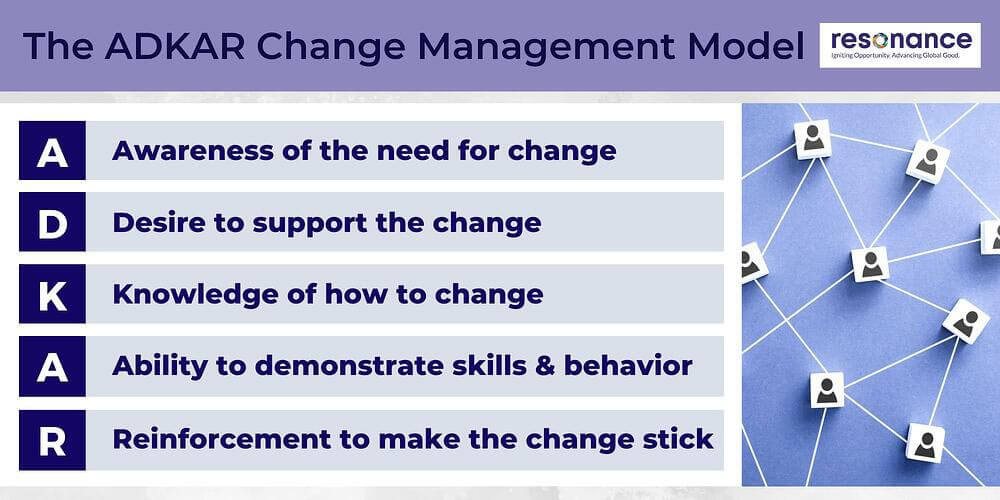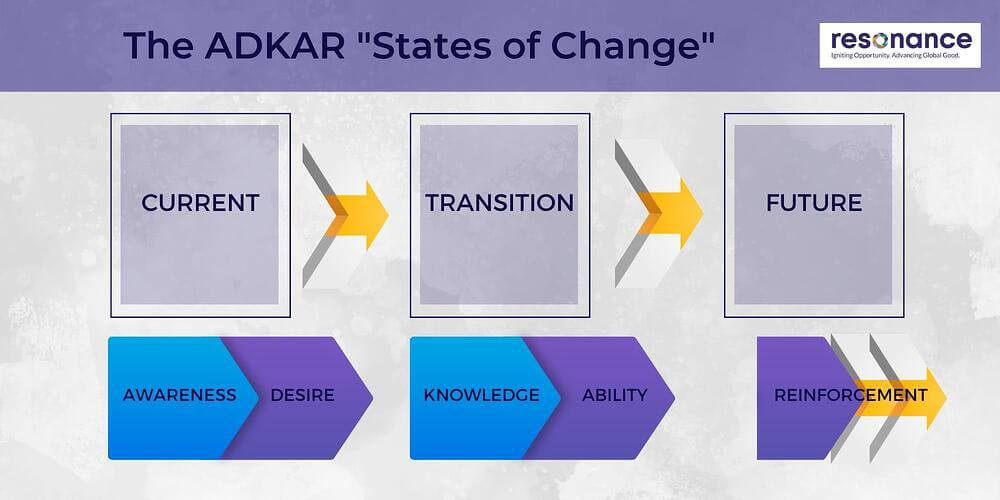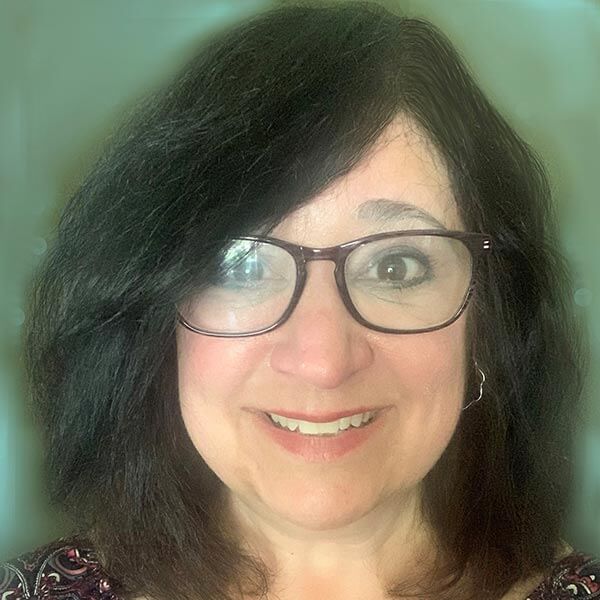The flurry of current organizational sustainability initiatives – from Scope emissions reductions, adoption of UNSDGs, to corporate social responsibility (CSR), ESG frameworks, biodiversity, and other commitments – has made one thing clear. We are collectively experiencing a period of breakpoint change – one in which the world’s intertwined challenges linked to climate change and other ‘wicked’ problems are by necessity transforming the way we approach business and economic development.
Addressing these problems is likely accompanied by requisite seismic shifts organizationally and across supply and value chains, impacting most if not all stakeholders. And transformational change can be daunting, not only for those leading efforts, but also those required to adopt, adapt, and advance new commitments, metrics, and initiatives.
There are many tools and approaches that are tied to change management that may prove useful to organizations embarking on undertakings that may require systemic shifts in attitudes and behaviors for success. The ADKAR Model of Change Management is one of them.
The ADKAR Model of Change Management is a Robust Tool in the Toolbox
Leaders of corporate sustainability efforts have shared they are looking for ways to not only assist their organizations in setting goals, establishing metrics, and developing tracking systems, but also in designing the people-centered processes that will help establish roadmaps, galvanize support (and hoped enthusiasm), and minimize disruption to ensure success.
The ADKAR model of change management is an established and recognized outcome-oriented method that aims to limit resistance to organizational change. It was created by Jeffrey Hiatt, the founder of Prosci, and is considered the Prosci change management methodology.
ADKAR is not the only model of change management model or approach that can be utilized as part of sustainability and impact initiatives; in fact, it is one of many as our recent Insights on 'theory of change' describes. Well-trained facilitators and good change management practitioners understand the need to implement and integrate approaches that are tailored to the organization.
This includes not only attentiveness to an organization's goals and articulated roadmaps, but also the structure, climate, and culture of an organization, as well as contextual intelligence about the broader often global landscape in which the company operates (i.e., supply and value chains).
We are highlighting the ADKAR Model of Change Management not only as an option among many approaches, but also because the model is widely used as part of USAID missions and partnership initiatives.
To understand the ADKAR methodology, let’s start with the acronym and what each letter stands for as depicted below.
In model form, below, we can see how ADKAR is about change management over three phases, the first, in which awareness and desire aim to move you out of the “Current State,” where change is needed but not yet begun. The second, Transition State, is marked by a focus on knowledge and ability; the third, the Future State, is realized by focusing on reinforcement.
 The kind of organizational change required to address complex problems can’t happen without buy-in from employees and stakeholders at all levels, which is always challenging. The philosophy behind the ADKAR approach is that change happens one individual at a time. Let’s see how it works.
The kind of organizational change required to address complex problems can’t happen without buy-in from employees and stakeholders at all levels, which is always challenging. The philosophy behind the ADKAR approach is that change happens one individual at a time. Let’s see how it works.
How To Apply The ADKAR Model Of Change Management in Support of Sustainable Impact
The ADKAR Model is outcome-oriented; thus, it can be used to facilitate change by setting clear milestones to be reached throughout the process to help drive sustainable impact.
Every person involved in a delineated change must reach each goal, though it is important to understand that different people may reach different goals at different times.
Sustainability leaders report that some people within their organizations already have the desire to change and are thus aligned with goals and more accepting of targets and proposed initiatives. Others may be slow to understanding that a challenge or problem even exists, and therefore do not necessarily see the links between the challenge and requisite need for change, yet.
In this way, the phase view of the ADKAR Change Management model demonstrates the ways in which different people may be working through different phases simultaneously. This model can be helpful then in mapping priorities that should be emphasized for change to become operationalized.
In addition, one of the most helpful benefits of the ADKAR Model is that its five sequential goals can identify areas of resistance. For instance, is someone unable to adopt and adapt to change because they do not understand why it needs to happen (Awareness), or do they recognize a need for the proposed change, but do not understand how to make it (Knowledge)?
Organizational change agents will be better prepared to guide team members and stakeholders through a stage once it becomes clear exactly where in the sequence they are stuck.
Taking one element at a time, let’s consider how sustainability leaders and organizational changemakers can put the ADKAR model into practice:
Goal 1: Create AWARENESS by Communicating a Compelling Need for Change
Change management requires ongoing communication, and not just one-way, top-down communication, but established processes that encourage two-way communication and engagement across ADKAR stages.
At the onset, communicating the need for change is foundational to sustainability efforts; however, creating awareness goes beyond simply announcing it. For team members and stakeholders to be truly aware of the necessity for change, they must understand not only the reasoning behind it, but they must also find agreement with that reasoning. And they need to care.
To meet those aims, your communication must be compelling.
Begin by providing clear explanations of why the change is needed. This speaks to developing simple, core messaging and a cohesive, relatable backstory. Simple doesn’t mean dumbing it down. It means getting to the core of the message and stripping away what is unnecessary, including technical jargon.
If you want people to care enough to pay attention, focus not only on the reasons for the change, but also the benefits of the change as they apply to the people impacted.
GOAL 2: Foster DESIRE by engaging and empowering employees and stakeholders to make the change
Just because employees are aware of the need for change and understand why a change should be made doesn’t mean they want that change.
For employees and stakeholders to adopt the change, they must desire it. And that can be a tall order for people who are uneasy during periods of upheaval, or for those who are content with things as they are.
There are processes you can implement that will help you foster the desire to make a specified change. Start by designating change leaders across the organization who will both show public support for the proposed change and will most naturally connect with those who will be impacted by it.
Change leaders don’t necessarily have to be departmental or organizational leaders. Cultivating those who can relate to how daily routines will be affected, and those who demonstrate the ability to provide support and guidance, may be the best suited for the task.
To foster desire and encourage empowerment, change leaders need to get specific about the benefits of the change as they apply to individuals and teams. Avoid touting advantages for the company.
When facilitating desire, some resistance should be anticipated, although it might turn up in the most expected places. It is critical that you understand the core reason for trepidations. Are people worried about how it will affect their day-to-day roles and duties? Are they afraid they don’t possess the skills to make the change? Are employees frustrated they don’t have the bandwidth to learn something new?
We have outlined an effective change management tool, the Ladder of Abstraction (“Why, What’s Stopping You?”), that may prove helpful in working to unearth the root cause of resistance. With understanding, leaders should address opposition and challenge head-on and if necessary, with processes for problem solving, adjusting implementation plans as necessary.
Goal 3: Provide KNOWLEDGE on how to change with an emphasis on Continuous Learning
The knowledge milestone in the ADKAR Model is primarily about education and training. In global development, this goal is aligned with the “L” in the acronym processes of Monitoring, Evaluation, and Learning (MEL). To transition as part of this phase, sustainability leadership will need to understand how individual and team responsibilities, skills, and processes will be impacted.
Knowledge-building is crucial to change management and should be specifically tailored to recognize that everyone in the organization will reach each milestone individually, and quite possibly, and different times.
Take time to develop knowledge approaches that apply directly to individual or team responsibilities during and after change is rooted. This means evaluating requirements for additional tools, skills, and duties that the change will require. Availability of time and resources for employees to acquire and master new skills or implement new processes is paramount to this goal. If scarce, implement the change gradually.
Sustainability leaders should consider partnering internally or externally to provide employee training including formal training, mentoring, online education (synchronous/asynchronous) and other opportunities.
Of course, knowledge-building should ideally go beyond facilitating specified change. It is equally important to provide knowledge that allows your team to see the change through to the end.
Goal 4: Ensure employees have the ABILITY to make the change by addressing obstacles
Regardless of how effective employees may be at performing a task, having confidence in their own competencies often determines whether they can or even will do something.
This is considered a gap between knowledge and ability.
To bridge this chasm, consider putting change agents and leaders in charge of coaching teams and individuals. In addition to mentoring and offering guidance, this process can support interval testing of change before the full roll-out, helping employees and stakeholders build confidence while simultaneously collecting feedback and assessing potential obstacles and roadblocks.
For large-scale changes, consider implementation in stages so you can identify issues early on and adjust your plans accordingly with effective solutions.
Goal 5: REINFORCE the change by keeping your eye on the ball
Managing change means attentiveness long after new processes and approaches are adopted and in place. Leaders need to both build and maintain enthusiasm and reinforce the change to ensure employees are on the right track and not slipping back into old practices and habits.
That’s why reinforcement should be a well-supported and critical phase in your change management plan.
Considerations important for maintaining momentum long-term include a balance of celebration of change implementers and their efforts to achieve milestones, and processes of correction that uplift rather than squash growing support.
In the meantime, continue to collect feedback and be receptive to active listening. The change process may be “complete,” but feedback is still valuable in identifying both pain and pivot points where support and readjustment might be required to ensure long-term success.
The ADKAR Model Of Change Management is a Widely-Used Approach
There are many approaches, models, and creative tools designed to help organizations lead and manage the kinds of change necessary to address the many pressing economic, environmental, and social challenges we are facing today.
The ADKAR model of change management is a widely-used approach that has been around for many years and is extensively field-tested. It guides leaders in developing and implementing effective change plans that will help organizations address these problems, while still delivering positive sustainable impact.
Resonance has an established track record of designing and utilizing phased-approaches to change management including using the ADKAR Change Management approach as part of global development initiatives as well as in our collaborations with private-sector clients and cross-sector partnerships.
Training in the ADKAR Model of Change Management Approach
Although we offer Change Management services (including Monitoring, Evaluation and Learning (MEL)) to private sector clients as a driver of our Sustainable Impact approach to solving sustainability and impact challenges, organizations often benefit from building internal changemaking capacity as well.
Sustainability leaders and training facilitators interested in training in the ADKAR Model of Change Management have several options. As the developer (and refiner) of the ADKAR Model, Prosci offers a Change Management Certification Program, one of the most widely-attended across options, offered with both virtual instruction-led, and in-person instruction options. This important change management approach is also introduced as part of toolbox options in a number of university-hosted and executive leadership change management certificate programs and training efforts as well.
If you are interested in exploring how you can integrate Change Management (and perhaps that includes the ADKAR Model of Change Management) into your sustainability and impact initiatives, and don't know where to start, we invite you to reach out to us to learn more.
Editor’s Note: This post has been updated for accuracy and current best practices.



